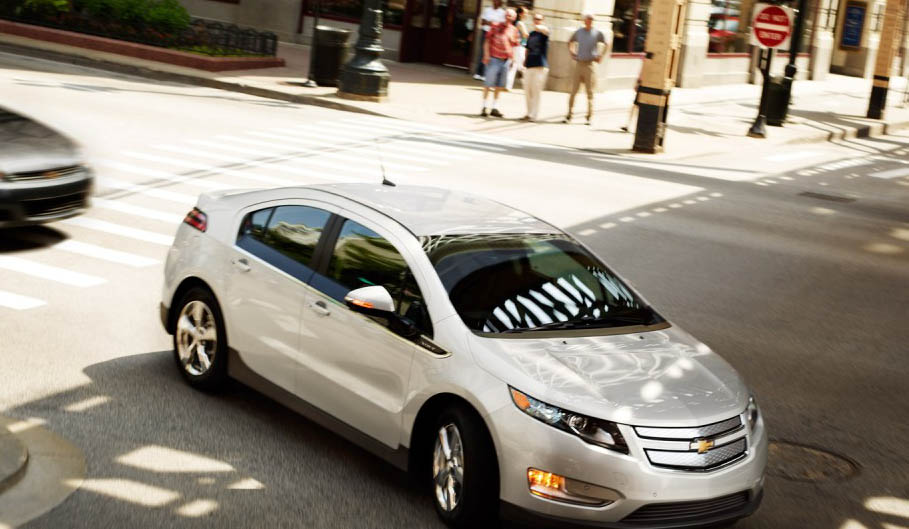Consumers Voting for Plug-in Hybrids Over EVs
The latest U.S. auto sales data reflect the view that plug-in hybrid vehicles will attract more buyers than battery-electric cars.

With few plug-in electric cars available, the sample of data is small. But a comparison of Nissan Leaf sales last month to the Chevy Volt and Toyota Plug-in Prius shows consumers opting for the longer range of plug-in hybrids.
Sales last month of the Nissan Leaf were higher than August but fell 4.6 percent in September compared to same period last year and its year-to-date numbers trail last year’s pace. So far, Nissan has sold 5,212 of its battery-electric hatchback sedans, compared to 7,199 by this time in 2011.
General Motors’ Chevy Volt, which runs mainly on its electric motor and has a gas engine that acts as a generator, saw a big jump in sales compared to last year and is on target to sell about double the amount of last year. There were 2,851 Chevy Volts sold last month, about the same as August, and the company has sold 16,348 of the plug-in electric cars this year. GM is still far off from its target of selling up to 45,000 Volts this year in the U.S.
Toyota’s Plug-in Prius, which was introduced later than the Leaf, has already eclipsed the Leaf in sales. The company sold 1,652 Plug-in Prius models last month and doubled sales compared to last year. So far it has sold 50 percent more plug-in hybrids than the Nissan Leaf, according to Greencar Reports. Sales of the all-electric Mitsubishi iMiev and Ford Focus Electric are far below Leaf sales, it said.
Last month’s auto sales also reflect solid consumer demand for smaller, more fuel-efficient cars. Sales at Ford and GM overall were tepid but both companies said small car sales growth was strongest. Toyota said sales of hybrids rose dramatically, up 120 percent to 26,747 in September.
Month-to-month sales can be heavily affected by dealer incentives. Officially, drivers can lease the Chevy Volt, for example, for $299 per month for three years with $2,899 down, but there are reports of better lease deals. Nissan executives said this week that improved incentives helped boost sales in September compared to August.
But even with month-to-month variations, the stronger sales this year of plug-in hybrids and hybrids over battery-electric cars fit the bigger technical trends in the auto industry.
As carmakers seek to meet fuel economy standards, they will squeeze more efficiencies from internal combustion engines, such as smaller engines with turbos, and use lighter materials. (See Stringent CAFE Standards Push Automakers.)
Hybrids add costs to vehicles, including batteries and electric motors, but automakers have been able to lower prices through incremental improvements and economies of scale. (See, Carmakers Find Cheaper Way to Make Hybrids.) Meanwhile, demand for battery electric vehicles has not been as high as anticipated a few years ago in part because the lithium ion batteries remain expensive. (See, Too Many Battery Factories, Too Few Electric Cars.)
Automakers will still make all-electric vehicles. Honda is making the Fit EV and Toyota’s RAV4 EV are out this year, although those are considered low-volume products made in part to comply with California regulations for zero-emissions vehicles. Tesla Motors, which sold about 200 Model S electric sedans last month, is committed to making only battery-electric vehicles.
But plug-in hybrids offer longer range, an important advantage for single-car owners. At the Paris Auto Show earlier this week, Volkswagen chief executive Martin Winterkorn said the company hasn’t dropped plans for battery electric vehicles but that plug-in hybrids offer the most practical path to reduce emissions.
“We had a realistic view of the technology all along,” he said at a company event, according to a report in the New York Times. “There will be, for a long time to come, no alternative to the internal combustion engine.”
Keep Reading
Most Popular
Large language models can do jaw-dropping things. But nobody knows exactly why.
And that's a problem. Figuring it out is one of the biggest scientific puzzles of our time and a crucial step towards controlling more powerful future models.
The problem with plug-in hybrids? Their drivers.
Plug-in hybrids are often sold as a transition to EVs, but new data from Europe shows we’re still underestimating the emissions they produce.
How scientists traced a mysterious covid case back to six toilets
When wastewater surveillance turns into a hunt for a single infected individual, the ethics get tricky.
Google DeepMind’s new generative model makes Super Mario–like games from scratch
Genie learns how to control games by watching hours and hours of video. It could help train next-gen robots too.
Stay connected
Get the latest updates from
MIT Technology Review
Discover special offers, top stories, upcoming events, and more.